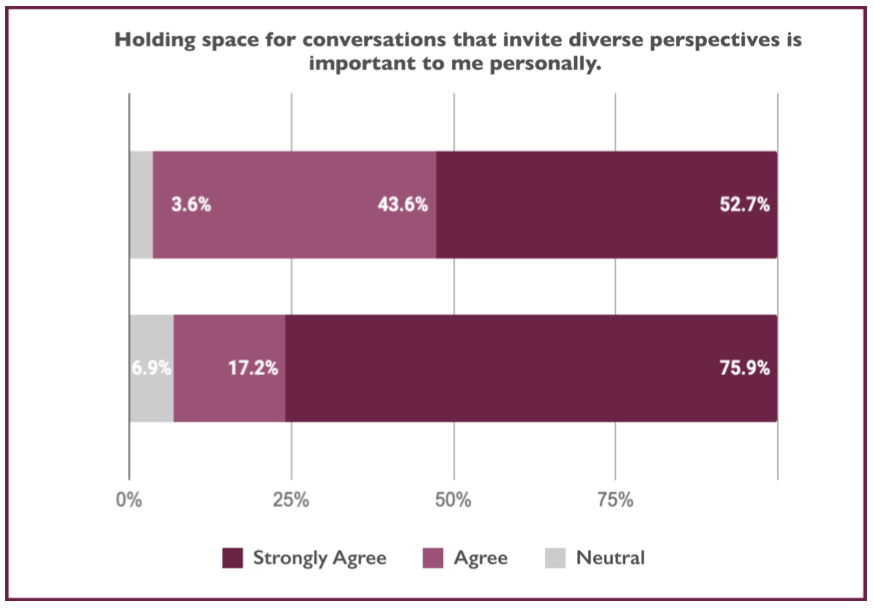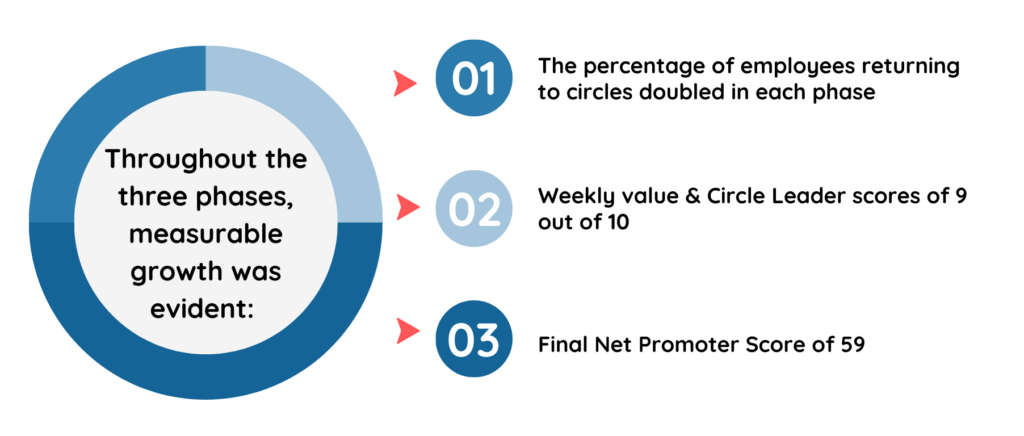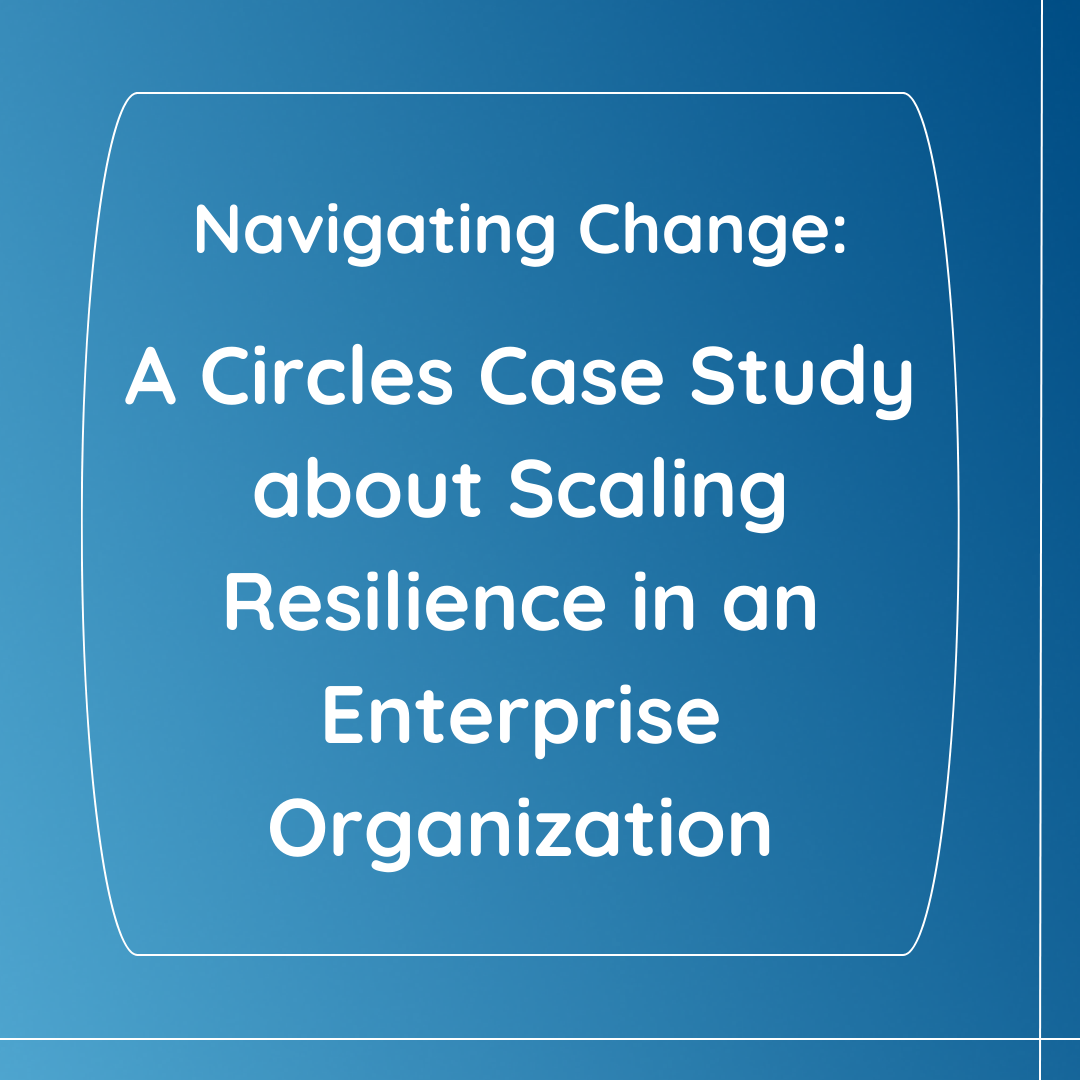Embarking on a journey of culture change at scale is no easy feat, but one DuPont division offers an inspiring tale of grassroots transformation. Despite daunting societal forces and internal disruptions, they embraced inclusive Circles experiences, fostering trust and resilience even throughout a merger and acquisition. Leaders emerged and were transformed into cultural ambassadors as they learned facilitation skills. What began as a single program promoting belonging multiplied into a lifeline of programs that profoundly humanized the way DuPonters connect and relate to one another.
In total, five Circles programs developed in partnership with DuPont:
- Community of Belonging—Inclusion sessions
- Navigating Change Together—Initial M&A processing
- Forging the Path Forward—Community focused
- Connection Circles—Merging teams
- Leader Connect—Peer Circles

Phase One: Community of Belonging
DuPont first discovered Circl.es while searching for ways employees could bring their full selves to work. Initially, they implemented Leadership Circles: A Community of Belonging (COB), a program created by The Aspen Institute in partnership with Circles Learning Labs. The program allows virtual space for leaders at all organizational levels to self-facilitate powerful dialogue–and DuPont employees who engaged the process celebrated differences while discovering commonalities.
Connecting New Hires and Senior Leaders

“Deliberately dedicating time to honest discussions with colleagues was some of the most beneficial time I’ve spent in the last couple of months.” DuPont Pilot Participant
70 employees took part in the COB pilot. A new hire who participated came away praising the experience as a safe, welcoming place: “Beginning my career with this experience has been incredibly valuable to me. It showed me that DuPont has a deep caring for people, and reinforced my decision to come to work here.”
Circles were deliberately sorted to group staff across organizational levels. One participant described feeling surprised by the vulnerable manner in which a senior leader in his group engaged. “It actually helps to have the company leader listening in on the hot issues and experiencing how people might be feeling.” What struck another employee was a specific, caring interaction during a rough day at work. “My boss came to me and said ‘I’m really wondering how I can show you kindness’–he had already been through two of the three Circle sessions. It was so nice to hear that type of comment from the leader of the entire organization.” Circles participants reported that Community of Belonging left them better equipped to have tough conversations with a manager or colleague.
Today’s workforce expects and appreciates avenues to cultivate workplace transparency. In fact, over 90% polled indicated that it’s DuPont’s responsibility as their employer to facilitate conversations. What truly transforms corporate culture is when senior leaders lead the way, engaging in the belonging process.
“My circle was a group of people across the organization, so it was a broad experience of my company rather than an experience with my direct co-workers.”
A New Type of Inclusive Experience
“At DuPont, we understand that we can only truly fulfill our purpose with the full commitment, participation, creativity, energy, and cooperative spirit of a diverse workforce.” Excerpt From DuPont’s Core Values
Although DuPont had run DEIB programs before, employees responded differently to the conversational format of the Leadership Circles sessions. Some indicated that beforehand, they had never considered the importance of inclusive work environments; after completing three 90-minute sessions, however, a stunning 100% agreed or strongly agreed with prioritizing inclusivity. They shared sentiments like “It’s a very open place to interact with colleagues and discuss the tough topics we don’t always talk about.”

Because personal conversations in safe spaces rarely occur at work, listening to others’
experiences revealed some startling realities. For example: previously unheard stories of workplace discrimination surfaced. As a result, the percentage of staff indicating they strongly valued conversations inviting diverse perspectives skyrocketed from 53%-76%.
One woman shared that her group gave her the courage to bring her most authentic, unique self to the space, also noting that “It gives DuPont a competitive edge. This is a win-win.” Human connection in small groups sets Circles programs apart from other belonging experiences.
“The readings, poems, and art were amazing conversation starters!”

Sparking a Movement
DuPont leaders knew they were on the path to culture change when three out of four participants they polled said they would recommend Community of Belonging to their colleagues. Ideas flowed, and opportunities to scale the circles throughout DuPont emerged. Meanwhile, following a long stretch of remote work, DuPont headed into 2022 facing significant change: competitor Celanese was acquiring their Mobility and Materials (M&M) division.
Phase Two: Navigating Change Together
Helping Teams Thrive Through Mergers & Acquisitions
Responding to the merger announcement, a small team of M&M leaders brainstormed how to apply the COB experience to the imminent acquisition. Forming a core team that included Circles team members, they created a customized Circles program Navigating Change Together (NCT) consisting of three new curated, facilitated, 90-minute sessions. After testing with pilot groups, they launched open enrollment over a period of months, inviting team members across regions & functions to process in virtual small groups together.
Participants shared personal motivations for joining:
- “We’ve had a lot of change in DuPont in the last five years, and it’s difficult to cope with constant change.”
- “Our team keeps getting smaller, so each one of us is more and more critical. We must support each other!”
- “I’m looking forward to this unique opportunity to learn and share, from head and heart!”
- “It is now more important than ever that we respectfully communicate, trust and support each other.”
NCT gave employees a safe space to share how they felt about the merger. Many processed their fears and insecurities. Their discussions forged strong connections and helped DuPonters build trust and harvest their collective strength. By connecting employees on a deeper level, the program acted as a lifeline buoying them through the organizational changes.
“I think the program is making me more resilient through adversity, and giving me more understanding of others. I heard surprising perspectives I couldn’t have even imagined. Professionally, this type of enrichment is of great benefit, and ultimately beneficial for results at work.”

Building a new Bench of Leaders
“I enjoyed my COB experience and the platform so much that I wanted to facilitate a Navigating Change Together circle; I’ve also contributed as a core planning team member. Circles allowed me to get back to supporting employees in the moment.”
Trained Circle Leaders have an enormous impact on the quality of a session. They’re equipped to allow uncomfortable ambiguity and uncertainty, holding space for discomfort and hard topics, asking challenging questions, and enabling meaningful discussions.
Here’s what participants have shared, praising their Circle Leaders:
- “They allowed us to participate without pressing anyone to talk. They just let the conversation flow and helped us build on each other’s thoughts.”
- “Our facilitator made a point of including everyone without putting people on the spot”
- “Encouraged open sharing and kept the discussion moving; created a welcoming environment for the conversation”
When Paula Tewksbury encountered Circles at DuPont, she recognized its unique potential to connect and grow employees. Her first role at DuPont was as a manufacturing professional in a plant, and evolved over time into a career as a Learning and Development leader. She’d been with DuPont for 30 years when, compelled by her experience as a COB participant, she volunteered as a NCT Circle Leader.
As a long time facilitator who had trained others for years, Paula noticed how Circles makes it easy for anyone to grow in facilitation skills. “By design, the Circles experience helps build skill sets like facilitation that sometimes get overlooked.”
Many COB participants besides Paula volunteered to facilitate a NCT circle, and notably, every single Circle Leader who facilitated in COB went on to lead a NCT circle. As one repeat facilitator shared, “The proudest moment for me was seeing two team members who I had invited into circles decide they wanted to facilitate circles going forward.” According to weekly reports, repeat Circle Leaders were instrumental in the program’s success.
By training over forty employees to become Circle Leaders, DuPont inherited a whole new bench of culture carriers prepared to help guide future organizational change.
Phase Three: Forging the Path Forward
The division continued preparing for the shift to Celanese. Aware of the mixed emotions employees would experience throughout the process, they designed and implemented a third phase of Circles called Forging the Path Forward. Together, participants reflected and prepared for the move: they set objectives to check in, assess M&M culture, and embrace the opportunity to move forward together.
Growing Pool of Seasoned Facilitators
The guidance of the experienced Circle Leaders–many of whom had led sessions since the very first phase–helped preserve the feeling of community and connection among their peers. 68% of NCT Circle Leaders guided circles again, allowing them to draw from prior experience and create meaningful sessions. A record-high facilitation score of 9.67 proved the importance of this seasoned throughline of leaders.
Outcomes
Programs Beyond the M&A
After moving from participant to facilitator, Paula continued seeing new leadership development opportunities for Circles. She and her continuous improvement colleague Lyle designed a Leader Connect program so leaders at the manufacturing level could address common challenges with peers in the same role at different sites. Together with Circles, they developed a program focused on leading with humility, developing people, engaging and asking the right questions, and providing a safe sharing environment. “Manufacturing Plant leaders and middle managers at sites don’t have peers to bounce ideas off of–there’s no one to connect and network with. Circles is a way to bring them together.”
Paula felt she watched culture change happening right before her eyes: accountability between the plant leaders increased, and they performed at a higher level as a result of connecting and growing through Leader Connect. Many participating leaders–some who had been with DuPont for decades–expressed that they had never experienced anything like it in their career.
Another product that emerged out of the M&A was Connection Circles, a program enabling initial employee connections across newly merged teams, beginning with Product Stewardship. One participant said functioning after a merger “feels like a high schoolS dance where boys are on one side and girls on another, and someone has to reach out and start communications between sides.” Circles helped ease the pain of two cultures merging.
Measurable Growth

The growing pool of Circle Leaders resulting from multiple phases of DuPont programs inspired us at Circles to continue refining our Facilitator Onboarding Journey, in an effort to translate the Circle Leaders experience into other organizations.

The Heart of the Matter
When leaders engage and hold space for human connection, culture changes one session at a time. Many of today’s most pressing workplace challenges factored into DuPont’s Circles journey, and the beating heart of each developed program is the belief that dialogue can build trusting relationships. The results at DuPont revealed the tremendous potential in employees connected with one another through significant organizational change.
